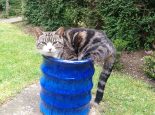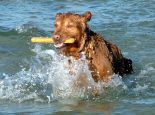Vet’s diary: just like you and me

Peterborough vet Laura Frost on how most pets are not so different from you and me...
It always amazes me that a lot of owners are surprised by how similar human and animal medicine is – my favourite, and somewhat extreme example, being an argument with my husband about whether cats have elbows. Just to dispel the myths once and for all, most mammals have all the same bits as we do, just in a slightly different angle or place. And although there are some species-specific illnesses, there is a huge overlap. Cats and dogs get diabetes and have urinary tract infections. A lot of medication is the same too.
The case that has made me think about all of this is Harry, an 18-monthold Border Collie who recently needed a blood transfusion. I first met him when he had eaten a block of rat poison from a neighbour’s farm during an early morning walk. As soon as I took the call I advised that they brought him to the surgery immediately but being an excitable young boy he had run away from the owner with the packet of rat bait in his mouth and didn’t reappear for several hours.
If animals have eaten something dangerous within the previous one to two hours we can give an injection to make them sick. Usually this will clear enough of the toxins from the stomach to reduce the risk of problems. Unfortunately in this case that golden period had gone and the risk of problems was quite high. Most rat poisons cause clotting issues. Vitamin K+ levels are reduced and patients bruise easily and can bleed in the abdomen and chest leading to anaemia and bleeding problems.
Harry was given injectable vitamin K as soon as he came to the practice. In some cases this is enough to offset the effects but Harry was not that lucky. Two days later he presented with some bruising to his gums and was wobbly on his legs. A blood test confirmed that his red blood cell count had dropped from 35% to 19%, which is serious, especially in the space of only a few days. Below 20% and the body begins to struggle. By this time Harry’s breathing was laboured as he tried to maximise the amount of oxygen being carried around his system. I called the owners back into the consult room to talk about the options.
I suggested that a blood transfusion would help to stabilise him giving the vitamin K a chance to work. Rather than asking how much it would cost or what his chances of a full recovery were, the conversation was as follows:
‘How on earth do you give a blood transfusion to a dog? I mean, I’ve had one myself but…’
‘It is actually quite similar, we take a unit of blood from another dog and give it slowly into the vein.’
‘Another dog’s blood you say. Ok. But how do you get it into the vein?’
‘We put a catheter into the vein first just like in people.’
‘But won’t it fall out if he moves?’
You get the picture. Sheer wonder coloured his face. I took that as permission to go ahead. Within the hour we had another vet’s greyhound patiently lying on his side while we took a unit of blood. As a seasoned donor he knows that a nice big dinner is waiting for him as a reward. As the blood is taken we carefully weigh it for the correct ratio of blood to anti-coagulant (a chemical that stops it from clotting in the bag). When full the bag weighs 350g. So this is where dog and people do vary a bit; blood types. Dogs do have blood types but are unlikely to react to a different blood type if it is their first transfusion, therefore any blood type can by used. During the first transfusion they can have antibodies to the foreign body so that they might react to it during a second transfusion. Therefore, Harry didn’t need to be blood-typed first; we could get the transfusion started straight away.
Even though the risk of reaction is low, we still start the transfusion very slowly and monitor things like temperature, heart rate and breathing. We start at one drip at a time going in very slowly via a special drip pump that calculates the rate very accurately. After 30 minutes we are happy that Harry is not reacting to the blood so we can speed up the transfusion. The colour of his gums improves before our eyes and before long he begins to look brighter. After the transfusion his red blood cell count has increased to 28%, which is much safer. He still needs to continue with vitamin K treatment for several weeks and will have regular blood test to make sure his anaemia fully resolves, but it is looking good.
Fingers crossed he makes a full recovery…
 Laura Frost MRCVS MA VetMB is a vet at local veterinary practice Pengelly and Mizen.
Laura Frost MRCVS MA VetMB is a vet at local veterinary practice Pengelly and Mizen.
Pengelly and Mizen Veterinary Surgeons 89-93 Park Road, Peterborough PE1 2TR T: 01733 554953 Emergencies only: 01733 896000 www.pengellyandmizen.co.uk
Image: www.freepik.com/free-vector/man-with-his-dog-going-for-a-walk_1042541















